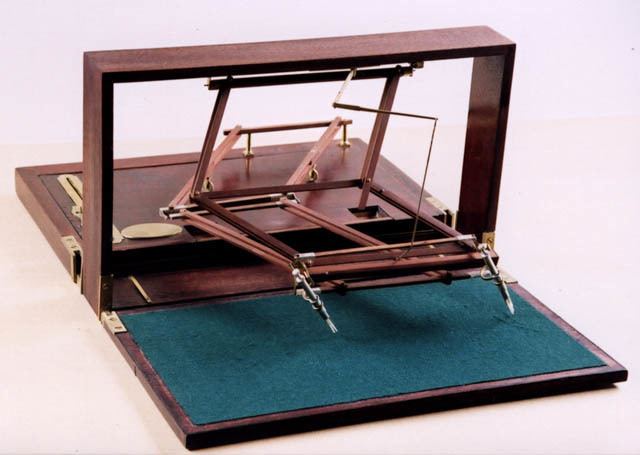 | ||
A Polygraph is a device that produces a copy of a piece of writing simultaneously with the creation of the original, using pens and ink.
Contents
- Description of the device
- Platform
- Bridge
- Inkwells
- Moving parts
- Planar pantograph
- Descending pantograph
- Pen lift transfer
- Viewing in museums
- Patent
- A modern version
- References
Patented by John Isaac Hawkins on May 17, 1803, it was most famously used by the third U.S. president, Thomas Jefferson, who acquired his first polygraph in 1804 and later suggested improvements to Charles Willson Peale, owner of the American rights. Because Jefferson was a prolific letter writer, the preservation of his copies have offered historians extensive insights into Jefferson's viewpoints and actions. Jefferson called the polygraph "the finest invention of the present age". A description of Jefferson's office routine in his own words may be read here.
Another American, Benjamin Henry Latrobe was the first customer of Peale's and not only introduced the device to Jefferson but was also instrumental in its improvement.
The quality of the copy made by a machine in good condition is so fine that it is considered by some that only characteristics other than the quality of the script (e.g., having been mailed, etc.) are reliable indicators (under the assumption that the original was mailed and not the copy), although a worn or maladjusted machine will produce specific indications in the copy.
Mechanisms of this type are more generally known as pantographs, which include simple devices for making copies at various enlargements or reductions by tracing over a drawing.
Description of the device
For a QuickTime animation see.
Platform
The platform forms both a writing surface (in part) and a base and reference plane for the moving and other stationary parts.("F" on diagram) In a portable device the platform is in two parts that form the covers of the enclosure formed for transport. As suggested by Jefferson, a non-portable version uses a single board for the entire platform.
Bridge
Also known as a "gallows frame", the bridge spans the platform ("A" and "B" on diagram). In the non-portable device this is mounted on posts permanently attached to the platform. In the portable version the bridge, side posts, and a bottom cross piece form the outer rim of enclosure when in the state for transportation.
The bridge divides the platform into two portions, the part toward the user upon which the papers are placed (see illustration above), and the stationary part away from the user that contains a portion of the planar pantograph. The function of the bridge is to form a base for the vertical movement linkage and a support for the suspension spring support beam.
Inkwells
Inkwells are provided beneath the bridge for each pen at corresponding locations. The dipping of the master pen will thus re-ink the slave pen.
Moving parts
The device consists of two pens transmitting motion in five degrees of freedom through four interlinked mechanisms:
- A horizontal pantograph maintains identical planar (X and Y axis) movement, with two degrees of freedom
- An angled pantograph descending from the bridge maintains identical vertical (Z axis) movement
- A torsion beam maintains identical pen fore-and-aft tilt
- A parallel linkage maintains identical pen side-to-side tilt
In addition, a vertical suspension spring balances the weight of the moving parts.
Planar pantograph
The range of the planar mechanism must be sufficient to encompass the papers (individually) being written upon and allow access for each pen to its respective inkwell.
A simple pantograph is used to translate the planar motion of one pen to the other. The pantograph consists of two complete variable parallelograms ("d" and "e" on diagram):
Descending pantograph
A second pair of parallelogram links maintains vertical correspondence between the two pens ("D" and "E" on diagram). These consist of two variable parallelogram frames attached at a common edge, one of which is also attached to the bridge, while the other is attached to one of the pen supports at each corner. The projecting sides of the upper frame consist of parallel linkages.
Pen lift transfer
The combination of forces between the horizontal and vertical enables the pen lift of the principal pen grasped by the user from the paper to be transferred to the copying pen.
Viewing in museums
Original polygraphs may be viewed at a number of locations around the world.
Some United States locations:
Patent
The original American patent document for the polygraph, issued to John J. Hawkins on May 17, 1803, was lost in a Patent Office fire in 1836.
A modern version
The Griffin Discovery Room at Monticello contains a simplified and durable version, intended for use by children. An image of this version in use may be seen here.[2]
